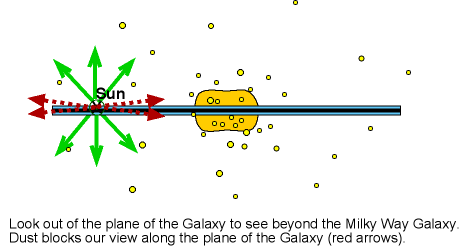This material (including images) is copyrighted!. See my copyright notice for fair use practices. Select the photographs to display the original source in another window. Most of the ground-based telescope pictures here are from the Anglo-Australian Observatory (AAO---used by permission). Links to external sites will be displayed in another window.
Irregular galaxies have no definite structure. The stars are bunched up but the patches are randomly distributed throughout the galaxy. Some irregulars have a lot of dust and gas so star formation is possible. Some are undergoing a burst of star formation now, so many H II regions are seen in them. Others have very little star formation going on in them (even some of those with a lot of gas and dust still in them).
Most irregulars are small and faint. The dwarf irregulars may be the most common type of galaxy in the universe (or maybe the dwarf ellipticals are). The estimates of the number of dwarf irregulars and dwarf ellipticals are based on the proportions of these types of galaxies in nearby groups. The dwarf galaxies far away are too faint to be seen and are, therefore, overlooked in surveys of the sky. Perhaps if the dwarf galaxies were brighter, Hubble would have arranged the galaxies in a different sequence instead of the two-pronged sequence. Examples of irregular galaxies are the Large and Small Magellanic Clouds (two small irregulars that orbit the Milky Way).
The sequence of images below starting from top left: the Large Magellanic Cloud (satellite of Milky Way), the Small Magellanic Cloud (satellite of Milky Way), IC 5152 (irregular in Local Group), NGC 3084 (=Messier 82, starburst irregular in M81 group), NGC 1313 (another starburst galaxy), NGC 6822 (irregular in Local Group).
Galaxies are distributed fairly uniformly across the sky. Approximately the same number of galaxies are seen in every direction you look except for a narrow 5 to 10 degree band along the Milky Way's mid-plane. That narrow band, called the ``zone of avoidance'', is created by the dust in the disk. The galaxies along that line-of-sight would be visible if the dust were not there. Radio waves are not affected by the dust and radio surveys show that there are, in fact, galaxies in the direction of the Milky Way's mid-plane.

The distribution of galaxies is not perfectly smooth. They clump together into loose groups. If you focus on just the galaxy positions on the sky, you get just a two-dimensional picture. Finding the distances to the galaxies allows you to get a three-dimensional view of the galaxy positions. Three-dimensional maps of the universe have revealed surprisingly large structures in the universe. Galaxies like to group together and those groups, in turn, congregate together.
![]() Go back to previous section --
Go back to previous section --
![]() Go to next section
Go to next section
last updated: June 28, 2022